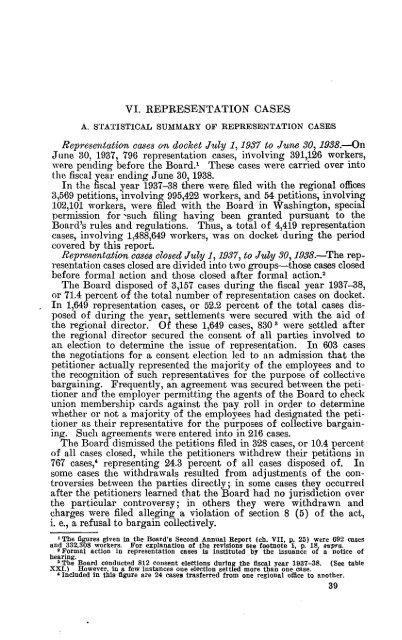NATIONAL LABOR RELATIONS BOARD
NATIONAL LABOR RELATIONS BOARD
NATIONAL LABOR RELATIONS BOARD
You also want an ePaper? Increase the reach of your titles
YUMPU automatically turns print PDFs into web optimized ePapers that Google loves.
VI. REPRESENTATION CASES<br />
A. STATISTICAL SUMMARY OF REPRESENTATION CASES<br />
Representation cases on docket July 1,1937 to June 30, 1938.—On<br />
June 30, 1937, 796 representation cases, involving 391,126 workers,<br />
were pending before the Board.' These cases were carried over into<br />
the fiscal year ending June 30, 1938.<br />
In the fiscal year 1937-38 there were filed with the regional offices<br />
3,569 petitions, involving 995,422 workers, and 54 petitions, involving<br />
102,101 workers, were filed with the Board in Washington, special<br />
permission for 'such filing having been granted pursuant to the<br />
Board's rules and regulations. Thus, a total of 4,419 representation<br />
cases, involving 1,488,649 workers, was on docket during the period<br />
covered by this report.<br />
Representation cases closed July 1, 1937, to Juky 30,1938.—The representation<br />
cases closed are divided into two groups—those cases closed<br />
before formal action and those closed after formal action.2<br />
The Board disposed of 3,157 cases during the fiscal year 1937-38,<br />
or 71.4 percent of the total number of representation cases on docket.<br />
In 1,649 representation cases, or 52.2 percent of the total cases disposed<br />
of during the year, settlements were secured with the aid of<br />
the regional director. Of these 1,649 cases, 830 3 were settled after<br />
the regional director secured the consent of all parties involved to<br />
an election to determine the issue of representation. In 603 cases<br />
the negotiations for a consent election led to an admission that the<br />
petitioner actually represented the majority of the employees and to<br />
the recognition of such representatives for the purpose of collective<br />
bargaining. Frequently, an agreement was secured between the petitioner<br />
and the employer permitting the agents of the Board to check<br />
uruon membership cards against the pay roll in order to determine<br />
whether or not a majority of the employees had designated the petitioner<br />
as their representative for the purposes of collective bargaining.<br />
Such agreements were entered into in 216 cases.<br />
The Board dismissed the petitions filed in 328 cases, or 10.4 percent<br />
of all cases closed, while the petitioners withdrew their petitions in<br />
767 cases,' representing 24.3 percent of all cases disposed of. In<br />
some cases the withdrawals resulted from adjustments of the controversies<br />
between the parties directly ; in some cases they occurred<br />
after the petitioners learned that the Board had no jurisdiction over<br />
the particular controversy; in others they were withdrawn and<br />
charges were filed alleging a violation of section 8 (5) of the act,<br />
i. e., a refusal to bargain collectively.<br />
I The figures given in the Board's Second Annual Report (di. VII, p. 25) were 692 cases<br />
and 332,308 workers. For explanation of the revisions see footnote 1, p. 18, supra.<br />
2 Formal action in representation cases is instituted by the issuance of a notice of<br />
hearing.<br />
The Board conducted 812 consent elections during the fiscal year 1937-38. (See table<br />
XXI.) However, in a few instances one election settled more than one case.<br />
Included in this figure are 24 cases trasferred from one regional office to another.<br />
39

















